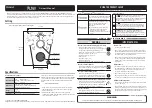
3-1
Section 3. CR9000 Measurement
Details
3.1 Measurements using the CR9041 A/D
The CR9050(E), CR9051E, and the CR9055(E) modules all use the A/D
module to digitize their analog measurements. Section 3.1 documents
measurement details for the measurements made using these modules. The
Filter module (CR9052DC) and the Isolation Module (CR9058E) both have an
A/D converter for each channel. The analog inputs are digitized by the
modules (the CR9041 A/D module is not used) and the digital data is sent
directly to the CR9000’s CPU module. The differences in measurement details
for these modules are covered in Sections 3.2 and 3.3. The measurement
details for the CR9070 and CR9071 Pulse modules are covered in Section 3.4.
3.1.1 Analog Voltage Measurement Sequence
The CR9000 measures analog voltages with a sample and hold analog to
digital (A/D) conversion. The signal at a precise instant is sampled and this
voltage is held or "frozen" while the digitization takes place. The A/D
conversion is made with a 16 bit successive approximation technique which
resolves the signal voltage to approximately one part in 62,500 of the full scale
range (e.g., for the ±5000 mV range, 10 V/62,500 = 160 µV). The analog
measurements are multiplexed through a single A/D converter with a
maximum conversion rate of 100,000 per second or one every 10 µs.
The timing of the CR9000 measurements is precisely controlled by the task
sequencer, a combination of components that switches the measurement
circuitry on a rigid schedule that is determined at compile time and loaded into
the task sequencer's memory. The basic tick of the task sequencer
measurement clock may be thought of as 10 µs. The minimum time between
measurements is 10 µs. When voltage signals are measured at a 10
µs/measurement rate, every 10 µs the task sequencer holds the signal from one
channel and then switches to the next channel. When the signal is held, the
A/D converter goes to work and ships the result off to the transputer memory.
The instructions executed by the task sequencer (e.g., hold, turn on the
excitation, switch to the next channel, etc.) take 400
η
s each. When measuring
every 10
µ
s, after holding for one measurement, the task sequencer switches to
the next channel (400
η
s), waits 9200
η
s, then holds for the next measurement
(400
η
s).
Changing voltage ranges requires one 10
µ
s tick; the task sequencer sets up the
new voltage range then delays until the next 10
µ
s boundary before switching
to the first channel. This only occurs before the first measurement within a
scan or when the voltage range actually changes.
Using two different voltage
measurement instructions with the same voltage range takes the same
measurement time as using one instruction with two repetitions.
(This is
not the case in the CR10, 21X and CR7 dataloggers where there is always a
setup time for each instruction.)
Содержание CR9000
Страница 6: ...CR9000 Table of Contents iv This is a blank page ...
Страница 22: ...CR9000 Overview OV 16 This is a blank page ...
Страница 26: ...Section 1 Installation 1 4 CR9000 FIGURE 1 1 3 CR9000 Battery Pack ...
Страница 72: ...Section 3 CR9000 Measurement Details 3 28 This is a blank page ...
Страница 88: ...Section 5 Program Declarations 5 6 This is a blank page ...
Страница 217: ...This is a blank page ...
















































